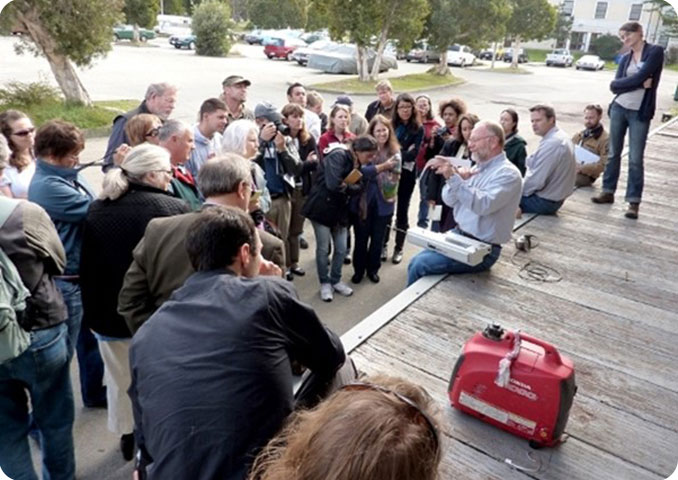
Community members learn about the Main Street Four Point Approach™ to revitalization in a training session
By Tekla Kilpatrick
Downtown Development Intern, WEDC
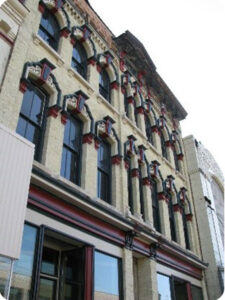
Unique architecture, such as this building in downtown Fond du Lac, creates a sense of place for visitors
I have been fortunate to work as an intern with WEDC’s downtown development team for the past 18 months, and during this time, I have gained a deeper understanding of and appreciation for how downtowns function and thrive. The following article offers five lessons from my year working with the Wisconsin Main Street Program, highlighting underappreciated tools and strategies communities can use to support strong downtowns.
1. Historic buildings give Main Street character
Historic buildings bring a sense of place to Main Street. Their unique aesthetics convey an overall sense of quality that reflects well on the downtown area and beyond, and they offer singular opportunities for storytelling that can define and differentiate the character of a community.
These buildings often incorporate architectural grandeur that would be cost-prohibitive to build today; renovating the buildings is not only important from a historic preservation standpoint but also cost-effective compared to building something similar as new construction. To mitigate budget concerns, there are funding tools available for renovations of historic buildings. For example, through Wisconsin’s Historic Preservation Tax Credit, any building listed on the State Historic Register can receive tax credits of up to 40% of eligible rehabilitation costs. The approval process takes time but is worthwhile as a building block for revitalizing downtowns.
2. Upper floor housing has been underutilized
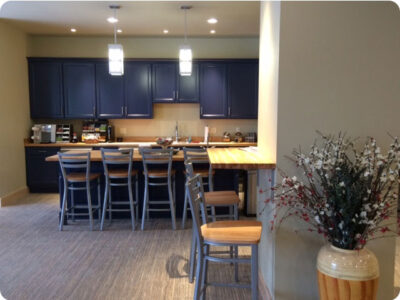
Upper-story residents on Main Streets can provide landlords with a steady stream of income.
Downtowns often have a significant number of vacant upper-level units. For example, one community studied had at least one vacant or underutilized floor in more than two-thirds of its downtown buildings. For these buildings, the empty space could accommodate up to 148 residential units.
Downtown businesses benefit greatly from having residents in these upper floors. Upper-story residents stimulate local businesses, as studies show that residents spend twice as much at businesses they can walk to. The presence of upper-level residents can also support new retail businesses, as landlords who have steady upstairs income are freer to take risks with retail spaces below, creating opportunities for local businesses over the ‘safer’ banks or insurance agencies preferred by landlords relying strictly on first floor rents to cover costs.
There are also safety benefits to filling upper-floor housing. Having more residents, business owners, and customers increases the number of “eyes on the street,” to borrow a phrase from the author Jane Jacobs—meaning there are more people to respond to or report an emergency or crime. Overall, increasing the number of upper-story residents on Main Streets will increase the economic vitality, small business growth, and safety of our downtowns.
3. Small storefronts are essential for entrepreneurs
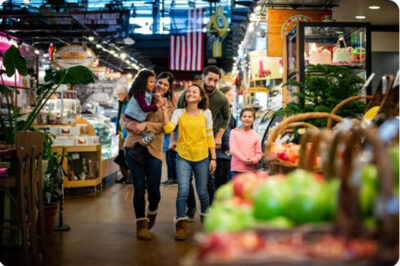
The Milwaukee Public Market showcases a diverse number of products available at business incubators. Image courtesy Wisconsin Department of Tourism
While unique and well-located, many existing downtown retail spaces are simply too large for startups. It is a huge jump to go from a farmer’s market booth to a traditional downtown storefront. Instead, small spaces (1,000 square feet or less) may better incubate these new businesses and help them size up for the future.
Business incubators like the Sherman Phoenix (Milwaukee), the Milwaukee Public Market, the Global Market and Food Hall (Madison), and other retail and food markets around the state have emerged to meet this need for smaller spaces. Such incubators place multiple small businesses together in a larger space, creating a critical mass of foot traffic.
Pop-up shop programs provide another Main Street option for startups. In these programs, a vacant building will host one or more small businesses for a short period of time. This allows emerging businesses to test a market and develop their concept before committing to a permanent storefront. In “window shopping,” an even smaller version of the pop-up shop, the front windows of vacant storefronts are used to display a business’s wares along with information about how passersby can buy them online.
4. Events are opportunities for businesses
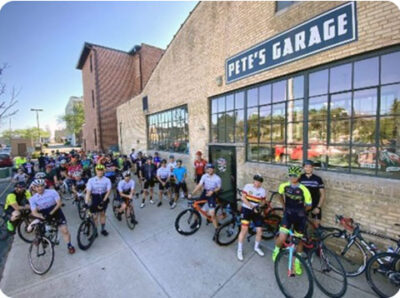
Preparing for a group ride outside Pete’s Garage in Green Bay
Events can entice new customers into a district, but businesses do not always effectively capitalize on this new foot traffic. Drawing customers off the street and inside requires both planning and creative thinking. Examples of successful strategies for capturing walk-in traffic during events include themed products or specials like cold (or hot) refreshments, limited-time-only product offerings, and/or children’s activities. Mobile events like business hops, wine walks, and boutique hops can also help businesses by introducing customers to new locations.
Businesses may also host in-store events to build a sustainable community of like-minded and loyal customers. For example, in addition to their daily business of selling bikes and cross-country skis, Pete’s Garage in Green Bay hosts weekly Tuesday night bike rides and repair clinics to introduce people to the sport. These events help customers feel invited to the store and may, over time, help grow a dedicated customer base.
5. Main Street requires collaboration and community
![A Touch of Class boutique in downtown La Crosse features window shopping options.]](https://wedc.org/wp-content/uploads/2024/05/store-front-window-display-lacrosse-640-400x300.jpg)
A Touch of Class boutique in downtown La Crosse features window shopping options
Communities sometimes struggle to meet their revitalization goals. They might believe change is impossible, fear change, or simply lack the political will required to effect change—leading new ideas to be met with an immediate “no.”
Community engagement and collaboration are essential to overcoming these obstacles. A genuinely collaborative approach to problem-solving can change a “no, because” response to a “yes, if” response—opening up possibilities for trying something new. Collective action to improve downtowns and their surrounding communities requires first building trust among key stakeholders.
Volunteer engagement is perhaps the single most important factor in successful downtown revitalization programs. While many communities have paid staff dedicated to promoting Main Street revitalization, the Main Street model for revitalization isn’t meant to be taken on by a single staffer or even by a single board of directors. Instead, this model assumes that engagement from the broader community will better ensure that everyone feels welcome downtown and that everyone understands they have a role to play in promoting a vibrant district.
If you want to help your local downtown, my last lesson from my year on Main Street is to consider becoming a volunteer. Volunteers can assist with day-to-day projects and event shifts and/or contribute skills like photography or marketing support. Everyone has something to offer! Contact your local downtown organization, merchant association, or civic group to identify opportunities for improving the community you love.
